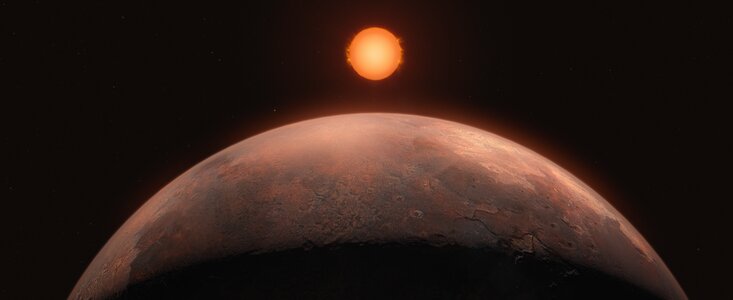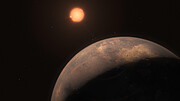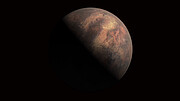Komunikat prasowy
Naukowcy odkryli planetę krążącą wokół najbliższej względem Słońca pojedynczej gwiazdy
1 października 2024
Korzystając z Bardzo Dużego Teleskopu (VLT), należącego do Europejskiego Obserwatorium Południowego (ESO), astronomowie odkryli egzoplanetę krążącą wokół gwiazdy Barnarda, najbliższej względem Słońca pojedynczej gwiazdy. Nowo odkryta planeta ma masę co najmniej połowy masy Wenus, a rok na niej trwa zaledwie nieco więcej niż trzy ziemskie dni. Obserwacje sugerują także, że mogą istnieć trzy dodatkowe kandydatki na planety, na różnych orbitach wokół gwiazdy.
Oddalona o zaledwie sześć lat świetlnych, gwiazda Barnarda jest drugim najbliższych systemem gwiazdowym – po systemie potrójnym Alfy Centauri – i najbliższą pojedynczą gwiazdą względem Układu Słonecznego. Dzięki swojej bliskości, jest to główny cel w poszukiwaniach egzoplanet podobnych do Ziemi. Pomimo obiecującej detekcji w 2018 roku, do tej pory nie było potwierdzonych planet okrążających gwiazdę Barnarda.
Odkrycie nowej egoplanety – ogłoszone w dzisiejszej publikacji w czasopiśmie „Astronomy & Astrophysics” – jest wynikiem obserwacji wykonywanych przez ostatnie pięć lat przy pomocy teleskopu VLT, znajdującego się w Obserwatorium Paranal w Chile. „Nawet jeśli zajmuje to dużo czasu, zawsze mamy przekonanie, że możemy coś znaleźć” mówi Jonay González Hernández, badacz z Instituto de Astrofísica de Canarias w Hiszpanii, pierwszy autor publikacji. Zespól poszukiwał sygnałów od ewentualnych planet pozasłonecznych w ekosferze (strefie nadającej się do zamieszkania) gwiazdy Barnarda – obszarze, w którym ciekła woda może istnieć na powierzchni planety. Czerwone karły, takie jak gwiazda Barnarda, często są wybierane za cel obserwacji przez astronomów, ponieważ małomasywne planety skaliste są tam łatwiejsze do wykrycia, niż w przypadku większy gwiazd podobnych do Słońca. [1]
Barnard b [2], jak nazwano nowo odkrytą planetę, jest dwadzieścia razy bliżej gwiazdy Barnarda niż Merkury od Słońca. Okrąża gwiazdę co 3,15 dnia ziemskiego i ma temperaturę powierzchniową około 125 °C. “Barnard b to jedna z najmniej masywnych znanych egzoplanet oraz jedna z niewielu znanych o masie mniejszej niż Ziemia. Ale planeta jest zbyt blisko swojej gwiazdy macierzystej, bliżej niż wypada ekosfera” wyjaśnia González Hernández. „Nawet biorąc pod uwagę, iż gwiazda jest o około 2500 stopni chłodniejsza niż Słońce, jest tam zbyt gorąco, aby utrzymać ciekłą wodę na powierzchni.”
Do swoich obserwacji zespół użył ESPRESSO, bardzo precyzyjnego instrumentu zaprojektowanego do pomiarów chybotania się gwiazdy spowodowanego grawitacyjnym przyciąganiem jednej lub więcej orbitujących wokół niej planet. Wyniki uzyskane z tych obserwacji zostały potwierdzone przez dane z innych instrumentów, także specjalizujących się w polowaniu na planety pozasłoneczne: HARPS w Obserwatorium La Silla, należącym do ESO, HARPS-N i CARMENES. Nowe dane nie wspierają jednak istnienia egzoplanety wskazanej w 2018 roku.
Oprócz potwierdzonej jednej planety, międzynarodowa grupa badawcza znalazła także wskazówki sugerujące istnienie trzech dodatkowych kandydatek na egzoplanet krążących wokół tej samej gwiazdy. Kandydatki te wymagają jednak dodatkowych obserwacji przy pomocy ESPRESSO, aby można je było uznać za potwierdzone. „Potrzebujemy teraz kontynuacji obserwowania tej gwiazdy, aby potwierdzić sygnały od pozostałych kandydatek” mówi Alejandro Suárez Mascareño, naukowiec z Instituto de Astrofísica de Canarias, współautor badań. „Odkrycie tej planety, razem innymi wcześniejszymi odkryciami, takimi jak Proxima b i d, pokazuje, że nasze kosmiczne podwórko jest pełne małomasywnych planet.”
Ekstremalnie Wielki Teleskop (ELT), obecnie w trakcie budowy przez ESO, dokona transformacji na polu badań egzoplanet. Jego instrument ANDES pozwoli naukowcom na wykrycie więcej małych, skalistych planet w ekosferach wokół pobliskich gwiazd, będących poza zasięgiem obecnych teleskopów. Pozwoli także na zbadanie składu atmosfer tych obiektów.
Uwagi
[1] Astronomowie wybierają chłodne gwiazdy, takie jak czerwone karły, ponieważ ich ekosfera znajduje się znacznie bliżej gwiazdy niż w przypadku gorętszych gwiazd, takich jak Słońce. Oznacza to, że planeta krążąca w tej strefie ma krótszy okres orbitalny, co pozwala astronomom na monitorowanie jej przez kilka dni lub tygodni, zamiast przez lata. Co więcej, czerwone karły są znacznie mniej masywne niż Słońce, a więc łatwiej zaburzyć je przez przyciąganie grawitacyjne planet wokół nich, czyli bardziej się poruszają.
[2] Powszechną praktyką w badaniach naukowych jest nazywanie egzoplanet nazwą ich gwiazdy macierzystej z dodanymi po niej małymi literami alfabetu, „b” wskazuje pierwszą znaną planetę, „c” kolejną, itd. nazwa Barnard b była więc wcześniej nadana poprzednio podejrzewanej planecie wokół tej gwiazdy, dla której naukowcy nie byli jednak w stanie potwierdzić jej istnienia.
Więcej informacji
Wyniki badań zaprezentowano w artykule pt. „A sub-Earth-mass planet orbiting Barnard’s star”, który ukaże się w “Astronomy & Astrophysics”. (https://www.aanda.org/10.1051/0004-6361/202451311)
Skład zespołu badawczego: J. I. González Hernández (Instituto de Astrofísica de Canarias, Spain [IAC] and Departamento de Astrofísica, Universidad de La Laguna, Spain [IAC-ULL]), A. Suárez Mascareño (IAC and IAC-ULL), A. M. Silva (Instituto de Astrofísica e Ciências do Espaço, Universidade do Porto, Portugal [IA-CAUP] and Departamento de Física e Astronomia Faculdade de Ciências, Universidade do Porto, Portugal [FCUP]), A. K. Stefanov (IAC and IAC-ULL), J. P. Faria (Observatoire de Genève, Université de Genève, Switzerland [UNIGE]; IA-CAUP and FCUP), H. M. Tabernero (Departamento de Física de la Tierra y Astrofísica & Instituto de Física de Partículas y del Cosmos, Universidad Complutense de Madrid, Spain), A. Sozzetti (INAF - Osservatorio Astrofisico di Torino [INAF-OATo] and Istituto Nazionale di Astrofisica, Torino, Italy), R. Rebolo (IAC; IAC-ULL and Consejo Superior de Investigaciones Científicas, Spain [CSIC]), F. Pepe (UNIGE), N. C. Santos (IA-CAUP; FCUP), S. Cristiani (INAF - Osservatorio Astronomico di Trieste, Italy [INAF-OAT] and Institute for Fundamental Physics of the Universe, Trieste, Italy [IFPU]), C. Lovis (UNIGE), X. Dumusque (UNIGE), P. Figueira (UNIGE and IA-CAUP), J. Lillo-Box (Centro de Astrobiología, CSIC-INTA, Madrid, Spain [CAB]), N. Nari (IAC; Light Bridges S. L., Canarias, Spain and IAC-ULL), S. Benatti (INAF - Osservatorio Astronomico di Palermo, Italy [INAF-OAPa]), M. J. Hobson (UNIGE), A. Castro-González (CAB), R. Allart (Institut Trottier de Recherche sur les Exoplanètes, Université de Montréal, Canada and UNIGE), V. M. Passegger (National Astronomical Observatory of Japan, Hilo, USA; IAC; IAC-ULL and Hamburger Sternwarte, Hamburg, Germany), M.-R. Zapatero Osorio (CAB), V. Adibekyan (IA-CAUP and FCUP), Y. Alibert (Center for Space and Habitability, University of Bern, Switzerland and Weltraumforschung und Planetologie, Physikalisches Institut, University of Bern, Switzerland), C. Allende Prieto (IAC and IAC-ULL), F. Bouchy (UNIGE), M. Damasso (INAF-OATo), V. D’Odorico (INAF-OAT and IFPU), P. Di Marcantonio (INAF-OAT), D. Ehrenreich (UNIGE), G. Lo Curto (European Southern Observatory, Santiago, Chile [ESO Chile]), R. Génova Santos (IAC and IAC-ULL), C. J. A. P. Martins (IA-CAUP and Centro de Astrofísica da Universidade do Porto, Portugal), A. Mehner (ESO Chile), G. Micela (INAF-OAPa), P. Molaro (INAF-OAT), N. Nunes (Instituto de Astrofísica e Ciências do Espaço, Universidade de Lisboa), E. Palle (IAC and IAC-ULL), S. G. Sousa (IA-CAUP and FCUP), and S. Udry (UNIGE).
Europejskie Obserwatorium Południowe (ESO) umożliwia naukowcom z całego świata na odkrywanie tajemnic Wszechświata z korzyścią dla nas wszystkich. Projektujemy, budujemy i zarządzamy światowej klasy obserwatoriami naziemnymi – których astronomowie używają do odpowiadania na ciekawe pytania i szerzenia fascynacji astronomią – a także promujemy międzynarodową współpracę w astronomii. Ustanowione w 1962 roku jako organizacja międzynarodowa, ESO jest wspierane przez 16 krajów członkowskich (Austria, Belgia, Czechy, Dania, Finlandia, Francja, Hiszpania, Irlandia, Holandia, Niemcy, Polska, Portugalia, Szwajcaria, Szwecja, Wielka Brytania oraz Włochy), a także Chile jako kraj gospodarz, oraz Australię jako strategicznego partnera. Siedziba ESO, a także jego centrum popularyzacji nauki i planetarium (ESO Supernova) znajdują się w pobliżu Monachium w Niemczech, natomiast chilijska pustynia Atakama – niesamowite miejsce z wyjątkowymi warunkami do obserwacji nieba – jest domem dla naszych teleskopów. ESO zarządza trzema lokalizacjami obserwacyjnymi w Chile: La Silla, Paranal i Chajnantor. W Paranal ESO posiada teleskop VLT (Very Large Telescope – Bardzo Duży Teleskop) oraz dwa teleskopy do przeglądów nieba. VISTA pracuje w podczerwieni, VLT Survey Telescope w zakresie widzialnym. W Paranal ESO zarządza także południowym obserwatorium CTA (Cherenkov Telescope Array South) – największym na świecie i najbardziej czułym obserwatorium promieniowania gamma. Wspólnie z międzynarodowymi partnerami ESO zarządza także radioteleskopami APEX i ALMA, które są instrumentami do obserwacji nieba w zakresach milimetrowym i submilimetrowym. Na Cerro Armazones, niedaleko Paranal, budujemy „największe oko świata na niebo”, czyli Ekstremalnie Wielki Teleskop (Extremely Large Telescope, ELT). Nasza działalność w Chile jest zarządzana z biur ESO w Santiago, gdzie współpracujemy też z chilijskimi partnerami.
Linki
- Publikacja naukowa
- Zdjęcia VLT
- Dla dziennikarzy: zasubskrybuj, aby otrzymywać w swoim języku nasze komunikaty prasowe z embargo medialnym
- Dla naukowców: jeśli masz ciekawe wyniki, zgłoś swoje badania
Kontakt
Jonay I. González Hernández
Instituto de Astrofísica de Canarias
Tenerife, Spain
Tel.: +34 922 605 751 or +34 922 605 200
E-mail: jonay.gonzalez@iac.es
Alejandro Suárez Mascareño
Instituto de Astrofísica de Canarias
Tenerife, Spain
Tel.: +34 658 778 954
E-mail: alejandro.suarez.mascareno@iac.es
Serena Benatti
INAF - Osservatorio Astronomico di Palermo
Palermo, Italy
Tel.: +39 091 233270
E-mail: serena.benatti@inaf.it
João Faria
Département d’astronomie de l’Université de Genève
Geneve, Switzerland
Tel.: +41 22 379 22 76
E-mail: joao.faria@unige.ch
André M. Silva
Instituto de Astrofísica e Ciências do Espaço, Universidade do Porto
Porto, Portugal
Tel.: +351 226 089 830
E-mail: Andre.Silva@astro.up.pt
Bárbara Ferreira
ESO Media Manager
Garching bei München, Germany
Tel.: +49 89 3200 6670
Tel. kom.: +49 151 241 664 00
E-mail: press@eso.org
Krzysztof Czart (Kontakt dla mediów Polska)
Sieć Popularyzacji Nauki ESO
oraz Urania - Postępy Astronomii
Toruń, Polska
Tel.: +48 513 733 282
E-mail: eson-poland@eso.org
O komunikacie
| Komunikat nr: | eso2414pl |
| Nazwa: | Barnard's Star |
| Typ: | Milky Way : Star |
| Facility: | Very Large Telescope |
| Instrumenty: | ESPRESSO |
| Science data: | 2024A&A...690A..79G |
Our use of Cookies
We use cookies that are essential for accessing our websites and using our services. We also use cookies to analyse, measure and improve our websites’ performance, to enable content sharing via social media and to display media content hosted on third-party platforms.
ESO Cookies Policy
The European Organisation for Astronomical Research in the Southern Hemisphere (ESO) is the pre-eminent intergovernmental science and technology organisation in astronomy. It carries out an ambitious programme focused on the design, construction and operation of powerful ground-based observing facilities for astronomy.
This Cookies Policy is intended to provide clarity by outlining the cookies used on the ESO public websites, their functions, the options you have for controlling them, and the ways you can contact us for additional details.
What are cookies?
Cookies are small pieces of data stored on your device by websites you visit. They serve various purposes, such as remembering login credentials and preferences and enhance your browsing experience.
Categories of cookies we use
Essential cookies (always active): These cookies are strictly necessary for the proper functioning of our website. Without these cookies, the website cannot operate correctly, and certain services, such as logging in or accessing secure areas, may not be available; because they are essential for the website’s operation, they cannot be disabled.
Functional Cookies: These cookies enhance your browsing experience by enabling additional features and personalization, such as remembering your preferences and settings. While not strictly necessary for the website to function, they improve usability and convenience; these cookies are only placed if you provide your consent.
Analytics cookies: These cookies collect information about how visitors interact with our website, such as which pages are visited most often and how users navigate the site. This data helps us improve website performance, optimize content, and enhance the user experience; these cookies are only placed if you provide your consent. We use the following analytics cookies.
Matomo Cookies:
This website uses Matomo (formerly Piwik), an open source software which enables the statistical analysis of website visits. Matomo uses cookies (text files) which are saved on your computer and which allow us to analyze how you use our website. The website user information generated by the cookies will only be saved on the servers of our IT Department. We use this information to analyze www.eso.org visits and to prepare reports on website activities. These data will not be disclosed to third parties.
On behalf of ESO, Matomo will use this information for the purpose of evaluating your use of the website, compiling reports on website activity and providing other services relating to website activity and internet usage.
Matomo cookies settings:
Additional Third-party cookies on ESO websites: some of our pages display content from external providers, e.g. YouTube.
Such third-party services are outside of ESO control and may, at any time, change their terms of service, use of cookies, etc.
YouTube: Some videos on the ESO website are embedded from ESO’s official YouTube channel. We have enabled YouTube’s privacy-enhanced mode, meaning that no cookies are set unless the user actively clicks on the video to play it. Additionally, in this mode, YouTube does not store any personally identifiable cookie data for embedded video playbacks. For more details, please refer to YouTube’s embedding videos information page.
Cookies can also be classified based on the following elements.
Regarding the domain, there are:
- First-party cookies, set by the website you are currently visiting. They are stored by the same domain that you are browsing and are used to enhance your experience on that site;
- Third-party cookies, set by a domain other than the one you are currently visiting.
As for their duration, cookies can be:
- Browser-session cookies, which are deleted when the user closes the browser;
- Stored cookies, which stay on the user's device for a predetermined period of time.
How to manage cookies
Cookie settings: You can modify your cookie choices for the ESO webpages at any time by clicking on the link Cookie settings at the bottom of any page.
In your browser: If you wish to delete cookies or instruct your browser to delete or block cookies by default, please visit the help pages of your browser:
Please be aware that if you delete or decline cookies, certain functionalities of our website may be not be available and your browsing experience may be affected.
You can set most browsers to prevent any cookies being placed on your device, but you may then have to manually adjust some preferences every time you visit a site/page. And some services and functionalities may not work properly at all (e.g. profile logging-in, shop check out).
Updates to the ESO Cookies Policy
The ESO Cookies Policy may be subject to future updates, which will be made available on this page.
Additional information
For any queries related to cookies, please contact: pdprATesoDOTorg.
As ESO public webpages are managed by our Department of Communication, your questions will be dealt with the support of the said Department.









